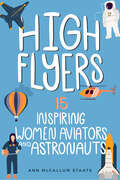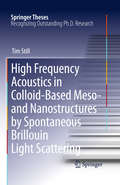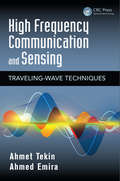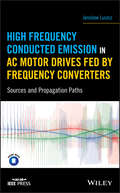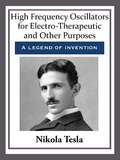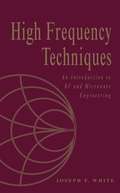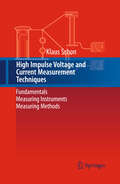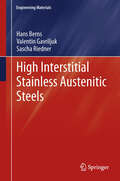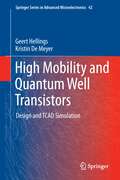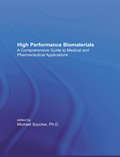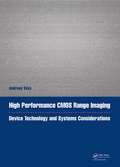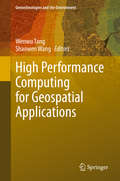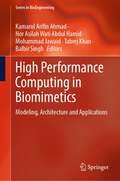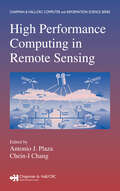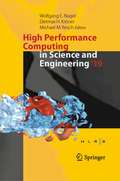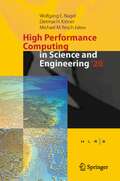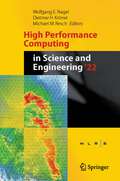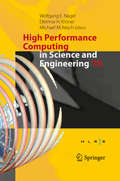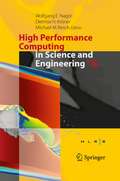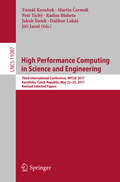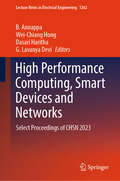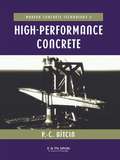- Table View
- List View
High Flyers: 15 Inspiring Women Aviators and Astronauts (Women of Power #6)
by Ann McCallum StaatsThese 15 women fly outside the lines. Soar beside Black Hawk helicopter pilot turned politician Tammy Duckworth, hot air balloonist Edgora McEwan, or medevac pilot Dede Murawsky. Higher up, meet commercial and military aviators such as the Coast Guard's Ronaqua Russell, the first African American female to receive the prestigious Air Medal for her rescue efforts during Hurricane Harvey. Next, ride along with Tammie Jo Shults, whose story includes a harrowing catastrophic engine failure while in command of 148 people aboard Southwest's Flight 1380. Others share their experiences in military high-performance jets, the Stratotanker, or while flying for the Blue Angels. Reaching past the bounds of Earth are astronauts who have launched in the cramped Russian rocket, the Soyuz, orbited Earth while conducting critical science experiments, or lived aboard the International Space Station. In all cases, the women in this book faced obstacles. Throughout their rise to incredible accomplishment, these courageous go-getters persevered and endured, insisting on success. Ultimately, each succeeded on her path to flight. These diverse high-flyers are dreamers and doers who believed, despite the odds, that soaring is possible.
High Frequency Acoustics in Colloid-Based Meso- and Nanostructures by Spontaneous Brillouin Light Scattering
by Tim StillThe present thesis deals with the exploration of phononic properties of meso- and nanostructured colloid-based composite materials at hypersonic (GHz) frequencies. The emerging field of phononics, the mechanical analogue of photonics, treats the propagation and manipulation of acoustic waves in structured materials. Due to their widely tunable properties (size, density, etc.) and their ability to self-assembly, polymer colloids are ideal systems to realize hypersonic phononics, which are investigated by Brillouin light scattering herein. Therefore, both the mechanical and physical properties of the individual colloidal particles, which manifest in their resonance vibrations (eigenmodes), as well as the acoustic propagation in colloidal structures have been investigated. This thesis already lead to several journal publications and seven presentations at international conferences, and was honored summa cum laude.
High Frequency Communication and Sensing: Traveling-Wave Techniques (Devices, Circuits, and Systems #35)
by Ahmet Tekin Ahmed EmiraHigh Frequency Communication and Sensing: Traveling-Wave Techniques introduces novel traveling wave circuit techniques to boost the performance of high-speed circuits in standard low-cost production technologies, like complementary metal oxide semiconductor (CMOS). A valuable resource for experienced analog/radio frequency (RF) circuit designers as well as undergraduate-level microelectronics researchers, this book: Explains the basics of high-speed signaling, such as transmission lines, distributed signaling, impedance matching, and other common practical RF background material Promotes a dual-loop coupled traveling wave oscillator topology, the trigger mode distributed wave oscillator, as a high-frequency multiphase signal source Introduces a force-based starter mechanism for dual-loop, even-symmetry, multiphase traveling wave oscillators, presenting a single-loop version as a force mode distributed wave antenna (FMDWA) Describes higher-frequency, passive inductive, and quarter-wave-length-based pumped distributed wave oscillators (PDWOs) Examines phased-array transceiver architectures and front-end circuits in detail, along with distributed oscillator topologies Devotes a chapter to THz sensing, illustrating a unique method of traveling wave frequency multiplication and power combining Discusses various data converter topologies, such as digital-to-analog converters (DACs), analog-to-digital converters (ADCs), and GHz-bandwidth sigma-delta modulators Covers critical circuits including phase rotators and interpolators, phase shifters, phase-locked loops (PLLs), delay-locked loops (DLLs), and more It is a significantly challenging task to generate and distribute high-speed clocks. Multiphase low-speed clocks with sharp transition are proposed to be a better option to accommodate the desired timing resolution. High Frequency Communication and Sensing: Traveling-Wave Techniques provides new horizons in the quest for greater speed and performance.
High Frequency Conducted Emission in AC Motor Drives Fed By Frequency Converters: Sources and Propagation Paths
by Jaroslaw LuszczProvides a concise and thorough reference for designing electrical and electronic systems that employ adjustable speed drives Electrical and electronic systems that employ adjustable speed drives are being increasingly used in present-day automation applications. They are considered by many application engineers as one of the most interfering components, especially in a contemporarily faced industrial environment. This book fills the gap between the high-level academic knowledge in the electromagnetic compatibility (EMC) field and the recommended practical rules for assuring electromagnetic compatibility margin. It focuses on finding and formulating the issues that often occur with the generation and propagation of conducted emission in AC motor drives fed by frequency converters, rather than proposing specific solutions for dealing with them. It also features explanations of selected academic backgrounds of EMC and presents practical case studies. The book starts with an introduction to conducted emission in adjustable speed drives. It then goes on to offer in-depth chapters covering conducted emission origins in switch-mode power converters; conducted emission generation by frequency converter in adjustable speed drives (ASD); propagation of motor side originated conducted emission towards the power grid; modeling of conducted emission in ASD; broadband behavior of ASD components; and impact of a motor feeding cable on CM currents generated in ASD. In addition, this resource: Presents state-of-the-art analysis of undesirable high frequency phenomena accompanying AC motor speed control Discusses the fundamentals of phenomena of electromagnetic interference (EMI) generation in switch mode static converters Provides methodology of modeling-conducted EMI generation and propagation in ASD High Frequency Conducted Emission in AC Motor Drives Fed By Frequency Converters: Sources and Propagation Paths will appeal to scholars and a wide range of professionals who are involved in the stages of development, design, and application of adjustable speed drives in accordance with ever-increasing EMC requirements.
High Frequency Oscillators for Electro-Therapeutic and Other Purposes
by Nikola TeslaNikola Tesla was a genius who revolutionized how the world looks at electricity.
High Frequency Techniques: An Introduction to RF and Microwave Design and Computer Simulation
by Joseph F. WhiteProvides a hands-on approach to Radio Frequency and Microwave theory and design This book provides engineers with a comprehensive guide to Radio Frequency (RF) circuit analysis and wave propagation in order to be able to design new systems. Emphasis is placed on fundamental concepts, engineering techniques, and the regular and intelligent use of the computer design tools. This book contains a review of wireless history and engineering fundamentals including complex numbers, alternating-current theory, and the logarithmic basis of decibels. The important topics in microwave design theory are discussed, such as transmission lines, the Smith Chart, and matrix algebra. Computer generated examples are used to provide insight into the basic performance, bandwidth, and manufacturing yield of RF and microwave networks. The author also provides a broad presentation of electromagnetic (EM) field theory tailored to the needs of the microwave and RF engineer. Explains how design challenges would be attacked in a real engineering environment Reviews AC analysis, Kirchhoff's laws, RLC elements, skin effect, and introduction to the use of computer simulation software *Covers filter designs for Butterworth, Chebyshev, Bessel and elliptic responses, Kuroda's identities, and Richard's transformation Provides in-text exercises to emphasize a practical approach Includes access to a companion site hosting an instructor's manual High Frequency Technique: An Introduction to RF and Microwave Design and Computer Simulation is a reference for RF, microwave, and wireless engineers, and graduate students in electrical and computer engineering.
High Impulse Voltage and Current Measurement Techniques: Fundamentals – Measuring Instruments – Measuring Methods
by Klaus SchonEquipment to be installed in electric power-transmission and distribution systems must pass acceptance tests with standardized high-voltage or high-current test impulses which simulate the stress on the insulation caused by external lightning discharges and switching operations in the grid. High impulse voltages and currents are also used in many other fields of science and engineering for various applications. Therefore, precise impulse-measurement techniques are necessary, either to prevent an over- or understressing of the insulation or to guarantee the effectiveness and quality of the application. The target audience primarily comprises engineers and technicians but the book may also be beneficial for graduate students of high-voltage engineering and electrical power supply systems.
High Interstitial Stainless Austenitic Steels
by Hans Berns Valentin Gavriljuk Sascha RiednerHigh Interstitial Stainless Austenitic Steels is of interest to all engineers and resaerchers working with stainless steel, either at universities or R&D departments in Industry. The new applications described appeal to design engineers while procees engineers find interesting challenges. These novel steels enter more and more industrial applications. Their development is presented by this book in its entirety, starting from the electronic scale of components. This makes it particlularly attractive to Materials Scientists and Metal Physicists.
High Mobility and Quantum Well Transistors
by Geert Hellings Kristin De MeyerFor many decades, the semiconductor industry has miniaturized transistors, delivering increased computing power to consumers at decreased cost. However, mere transistor downsizing does no longer provide the same improvements. One interesting option to further improve transistor characteristics is to use high mobility materials such as germanium and III-V materials. However, transistors have to be redesigned in order to fully benefit from these alternative materials. High Mobility and Quantum Well Transistors: Design and TCAD Simulation investigates planar bulk Germanium pFET technology in chapters 2-4, focusing on both the fabrication of such a technology and on the process and electrical TCAD simulation. Furthermore, this book shows that Quantum Well based transistors can leverage the benefits of these alternative materials, since they confine the charge carriers to the high-mobility material using a heterostructure. The design and fabrication of one particular transistor structure - the SiGe Implant-Free Quantum Well pFET - is discussed. Electrical testing shows remarkable short-channel performance and prototypes are found to be competitive with a state-of-the-art planar strained-silicon technology. High mobility channels, providing high drive current, and heterostructure confinement, providing good short-channel control, make a promising combination for future technology nodes.
High Modulus Polymers: Approaches to Design and Development
by Roger S. Porter Anagnostis E. ZachariadesThis book reflects understanding of property enhancement through development of molecular structure. It focuses on liquid crystalline and semicrystalline polymers that provide a state of the art knowledge of the molecular organizations.
High Performance Biomaterials: A Complete Guide to Medical and Pharmceutical Applications
by Michael SzycherEncyclopedic presentation of the clinical applications of biomaterials from markets and advanced concepts to pharmaceutical applications and blood compatibility.
High Performance CMOS Range Imaging: Device Technology and Systems Considerations (Devices, Circuits, and Systems)
by Andreas SüssThis work is dedicated to CMOS based imaging with the emphasis on the noise modeling, characterization and optimization in order to contribute to the design of high performance imagers in general and range imagers in particular. CMOS is known to be superior to CCD due to its flexibility in terms of integration capabilities, but typically has to be enhanced to compete at parameters as for instance noise, dynamic range or spectral response. This work gathers the widespread theory on noise and extends the theory by a non-rigorous but potentially computing efficient algorithm to estimate noise in time sampled systems.
High Performance Computing for Geospatial Applications (Geotechnologies and the Environment #23)
by Shaowen Wang Wenwu TangThis volume fills a research gap between the rapid development of High Performance Computing (HPC) approaches and their geospatial applications. With a focus on geospatial applications, the book discusses in detail how researchers apply HPC to tackle their geospatial problems. Based on this focus, the book identifies the opportunities and challenges revolving around geospatial applications of HPC. Readers are introduced to the fundamentals of HPC, and will learn how HPC methods are applied in various specific areas of geospatial study. The book begins by discussing theoretical aspects and methodological uses of HPC within a geospatial context, including parallel algorithms, geospatial data handling, spatial analysis and modeling, and cartography and geovisualization. Then, specific domain applications of HPC are addressed in the contexts of earth science, land use and land cover change, urban studies, transportation studies, and social science. The book will be of interest to scientists and engineers who are interested in applying cutting-edge HPC technologies in their respective fields, as well as students and faculty engaged in geography, environmental science, social science, and computer science.
High Performance Computing in Biomimetics: Modeling, Architecture and Applications (Series in BioEngineering)
by Mohammad Jawaid Tabrej Khan Kamarul Arifin Ahmad Balbir Singh Nor Asilah Wati Abdul HamidThis book gives a complete overview of current developments in the implementation of high performance computing (HPC) in various biomimetic technologies. The book presents various topics that are subdivided into the following parts: A) biomimetic models and mechanics; B) locomotion and computational methods; C) distributed computing and its evolution; D) distributed and parallel computing architecture; E) high performance computing and biomimetics; F) big data, management, and visualization; and G) future of high performance computing in biomimetics. This book presents diverse computational technologies to model and replicate biologically inspired design for the purpose of solving complex human problems. The content of this book is presented in a simple and lucid style which can also be used by professionals, non-professionals, scientists, and students who are interested in the research area of high performance computing applications in the development of biomimetics technologies.
High Performance Computing in Remote Sensing
by Chein-I Chang Antonio J. PlazaSolutions for Time-Critical Remote Sensing ApplicationsThe recent use of latest-generation sensors in airborne and satellite platforms is producing a nearly continual stream of high-dimensional data, which, in turn, is creating new processing challenges. To address the computational requirements of time-critical applications, researchers
High Performance Computing in Science and Engineering '19: Transactions of the High Performance Computing Center, Stuttgart (HLRS) 2019
by Wolfgang E. Nagel Michael M. Resch Dietmar H. KrönerThis book presents the state-of-the-art in supercomputer simulation. It includes the latest findings from leading researchers using systems from the High Performance Computing Center Stuttgart (HLRS) in 2019. The reports cover all fields of computational science and engineering ranging from CFD to computational physics and from chemistry to computer science with a special emphasis on industrially relevant applications. Presenting findings of one of Europe’s leading systems, this volume covers a wide variety of applications that deliver a high level of sustained performance.The book covers the main methods in high-performance computing. Its outstanding results in achieving the best performance for production codes are of particular interest for both scientists and engineers. The book comes with a wealth of color illustrations and tables of results.
High Performance Computing in Science and Engineering '20: Transactions of the High Performance Computing Center, Stuttgart (HLRS) 2020
by Wolfgang E. Nagel Michael M. Resch Dietmar H. KrönerThis book presents the state-of-the-art in supercomputer simulation. It includes the latest findings from leading researchers using systems from the High Performance Computing Center Stuttgart (HLRS) in 2020. The reports cover all fields of computational science and engineering ranging from CFD to computational physics and from chemistry to computer science with a special emphasis on industrially relevant applications. Presenting findings of one of Europe’s leading systems, this volume covers a wide variety of applications that deliver a high level of sustained performance.The book covers the main methods in high-performance computing. Its outstanding results in achieving the best performance for production codes are of particular interest for both scientists and engineers. The book comes with a wealth of color illustrations and tables of results.
High Performance Computing in Science and Engineering '22: Transactions of the High Performance Computing Center, Stuttgart (HLRS) 2022
by Wolfgang E. Nagel Michael M. Resch Dietmar H. KrönerThis book presents the state-of-the-art in supercomputer simulation. It includes the latest findings from leading researchers using systems from the High Performance Computing Center Stuttgart (HLRS) in 2022. The reports cover all fields of computational science and engineering ranging from CFD to computational physics and from chemistry to computer science with a special emphasis on industrially relevant applications. Presenting findings of one of Europe’s leading systems, this volume covers a wide variety of applications that deliver a high level of sustained performance.The book covers the main methods in high-performance computing. Its outstanding results in achieving the best performance for production codes are of particular interest for both scientists and engineers. The book comes with a wealth of color illustrations and tables of results.
High Performance Computing in Science and Engineering ´15: Transactions of the High Performance Computing Center, Stuttgart (HLRS) 2015
by Wolfgang E. Nagel Michael M. Resch Dietmar H. KrönerThis book presents the state-of-the-art in supercomputer simulation. It includes the latest findings from leading researchers using systems from the High Performance Computing Center Stuttgart (HLRS) in 2015. The reports cover all fields of computational science and engineering ranging from CFD to computational physics and from chemistry to computer science with a special emphasis on industrially relevant applications. Presenting findings of one of Europe’s leading systems, this volume covers a wide variety of applications that deliver a high level of sustained performance. The book covers the main methods in high-performance computing. Its outstanding results in achieving the best performance for production codes are of particular interest for both scientists and engineers. The book comes with a wealth of color illustrations and tables of results.
High Performance Computing in Science and Engineering ´16
by Wolfgang E. Nagel Michael M. Resch Dietmar H. KrönerThis book presents the state-of-the-art in supercomputer simulation. It includes the latest findings from leading researchers using systems from the High Performance Computing Center Stuttgart (HLRS) in 2016. The reports cover all fields of computational science and engineering ranging from CFD to computational physics and from chemistry to computer science with a special emphasis on industrially relevant applications. Presenting findings of one of Europe's leading systems, this volume covers a wide variety of applications that deliver a high level of sustained performance. The book covers the main methods in high-performance computing. Its outstanding results in achieving the best performance for production codes are of particular interest for both scientists and engineers. The book comes with a wealth of color illustrations and tables of results.
High Performance Computing in Science and Engineering ´16: Transactions of the High Performance Computing Center, Stuttgart (HLRS) 2016
by Wolfgang E. Nagel Michael M. Resch Dietmar H. KrönerThis book presents the state-of-the-art in supercomputer simulation. It includes the latest findings from leading researchers using systems from the High Performance Computing Center Stuttgart (HLRS) in 2016. The reports cover all fields of computational science and engineering ranging from CFD to computational physics and from chemistry to computer science with a special emphasis on industrially relevant applications. Presenting findings of one of Europe’s leading systems, this volume covers a wide variety of applications that deliver a high level of sustained performance.The book covers the main methods in high-performance computing. Its outstanding results in achieving the best performance for production codes are of particular interest for both scientists and engineers. The book comes with a wealth of color illustrations and tables of results.
High Performance Computing in Science and Engineering: Third International Conference, HPCSE 2017, Karolinka, Czech Republic, May 22–25, 2017, Revised Selected Papers (Lecture Notes in Computer Science #11087)
by Tomáš Kozubek Radim Blaheta Jakub Šístek Martin Čermák Petr Tichý Dalibor Lukáš Jiří JarošThis book constitutes the thoroughly refereed post-conference proceedings of the Third International Conference on High Performance Computing in Science and Engineering, HPCSE 2017, held in Karolinka, Czech Republic, in May 2017.The 15 papers presented in this volume were carefully reviewed and selected from 20 submissions. The conference provides an international forum for exchanging ideas among researchers involved in scientific and parallel computing, including theory and applications, as well as applied and computational mathematics. The focus of HPCSE 2017 was on models, algorithms, and software tools which facilitate efficient and convenient utilization of modern parallel and distributed computing architectures, as well as on large-scale applications.
High Performance Computing, Smart Devices and Networks: Select Proceedings of CHSN 2023 (Lecture Notes in Electrical Engineering #1262)
by Wei-Chiang Hong G. Lavanya Devi B. Annappa Dasari HarithaThis book comprises the proceedings of the 4th International Conference on Computer Vision, High-Performance Computing, Smart Devices, and Networks (CHSN 2023). This book highlights high-quality research articles in machine learning, computer vision, and networks. The content of this volume gives the reader an up-to-date picture of the state-of-the-art connection between computational intelligence, machine learning, and IoT. The papers in this volume are peer-reviewed by experts in related areas. The book serves as a valuable reference resource for academics and researchers across the globe.
High Performance Concrete
by Pierre-Claude AïtcinA complete review of the fast-developing topic of high performance concrete (HPC) by one of the leading researchers in the field. It covers all aspects of HPC from materials, properties and technology, to construction and testing. The book will be valuable for all concrete technologists and construction engineers wishing to take advantage of the re
High Performance Concrete Optimal Composition Design
by Leonid Dvorkin Vadim Zhitkovsky Yuri Ribakov Oleh BordiuzhenkoConcrete and reinforced concrete remain the main building materials for construction of modern fortifications. The book presents experimental and theoretical results allowing production of special high-strength rapid hardening concrete and fiber reinforced concrete. It describes a method for effective proportioning of high-strength fast-setting concrete and fiber reinforced concrete with high dynamic strength as well as selecting proper technological parameters, methodology for design of reinforced concrete structures using such concrete. Particular attention is paid to ensuring the early strengthening of concrete within 24 hours after casting and to constructing structures with limited energy resources at the site.
